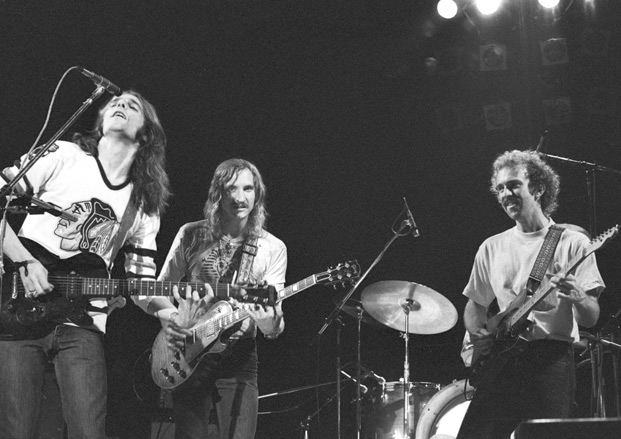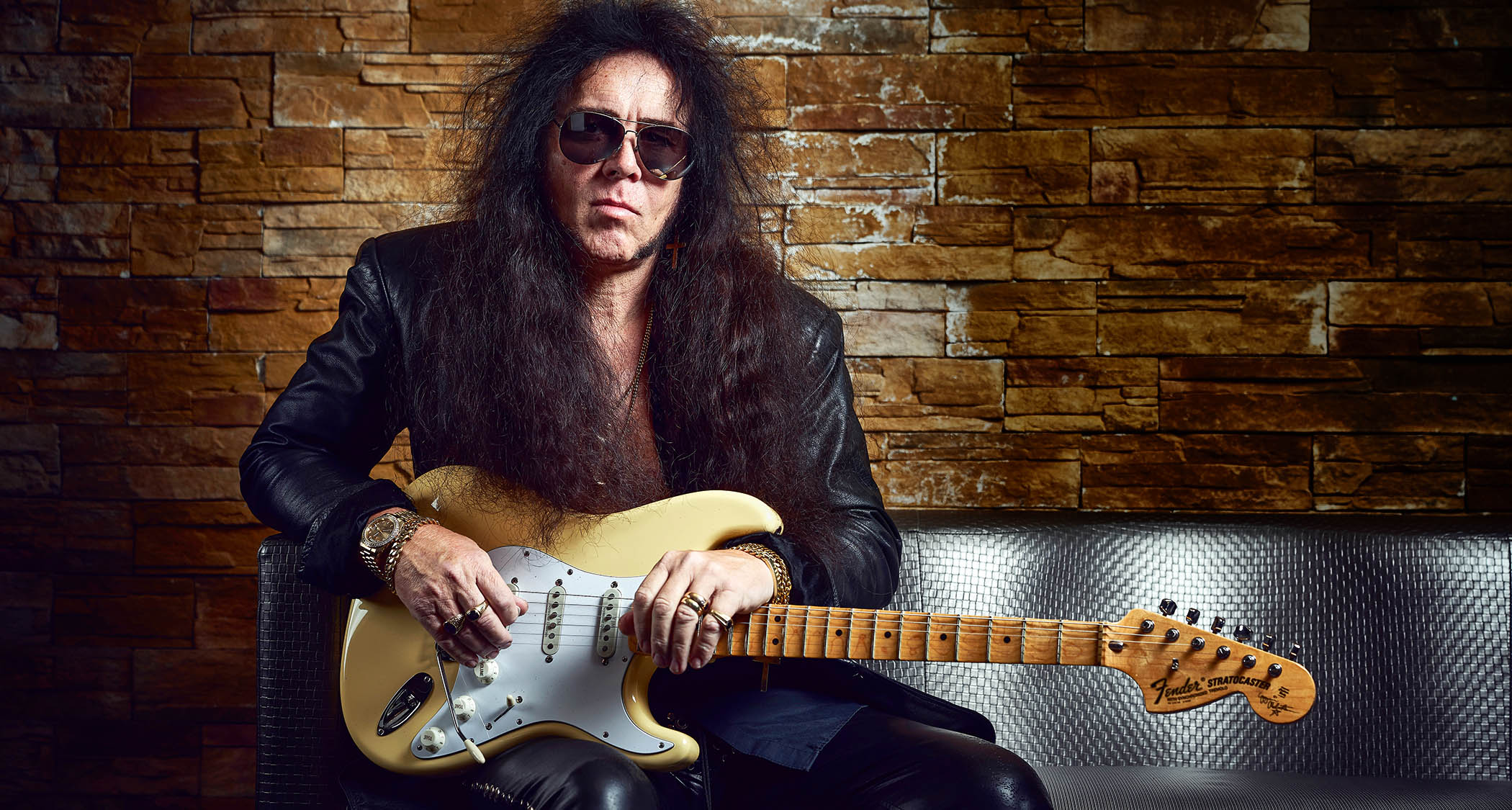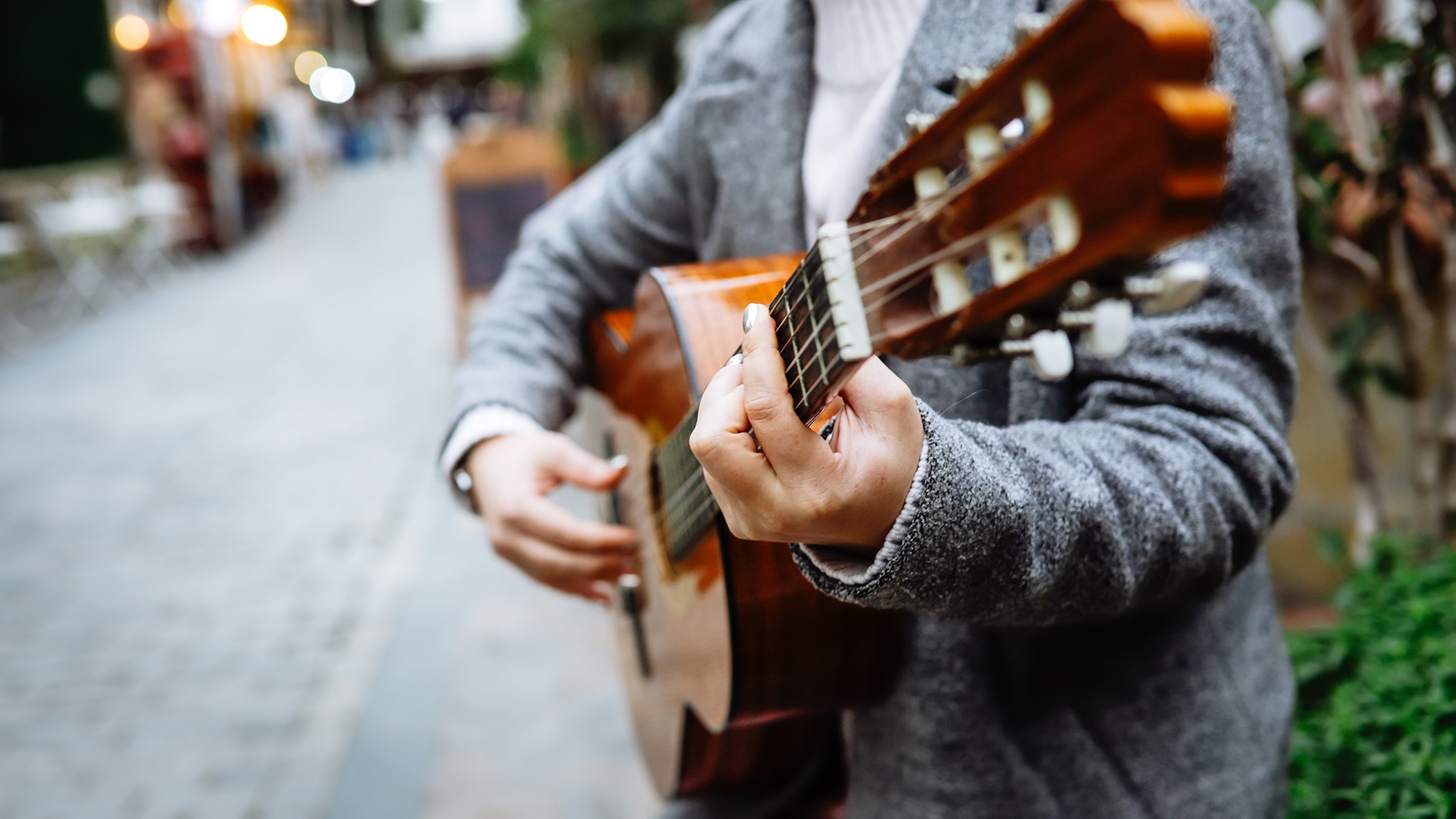The Eagles' 20 Greatest Songs

Below, Guitar World rounds up the top 19 Eagles tracks and breaks them down in an effort to provide some insight into what made this legendary guitar ensemble soar to great heights.
And yes, you read that right; there are only 19 songs on this list. We'd like your input—via the comments below, Facebook or Twitter—on the song that deserves to be Number 20. Let us know your thoughts!
19. “Doolin-Dalton” | Desperado
Glenn Frey has stated that the idea for the song “Doolin-Dalton,” was born from a jam session following a Tim Hardin concert, wherein they decided to give the next album an “anti-hero” theme. “Doolin-Dalton” is the opening track on the 1973 release and features lead vocals by Don Henley and Glenn Frey, acoustic guitar and harmonica by Frey and lead guitar by original Eagles member Bernie Leadon.
The Eagles’ songwriting partner Jackson Browne had turned the band onto a book about the Old West that included colorful stories about Bill Dalton, the American outlaw and prominent figure of the notorious Dalton Gang, and Bill Doolin, the founder of the equally violent Wild Bunch.
“Doolin-Dalton” is a slow, country-style song with a plaintive vocal melody and is a perfect vehicle for the expertly crafted vocal harmonies and instrumental work that define the Eagles’ sound.
18. “In the City” | The Long Run
Get The Pick Newsletter
All the latest guitar news, interviews, lessons, reviews, deals and more, direct to your inbox!
Surrounded by such formidable songwriting talent as Glenn Frey, Don Henley and Don Felder, Joe Walsh was unfortunately relegated to very few songwriting opportunities. His powerful pop masterpiece “In the City” was first recorded for the soundtrack to the 1979 movie, The Warriors, used for the movie’s closing credits. The song’s powerful rock groove sets up superlative vocal hooks and great signature slide guitar work. Henley and Frey loved the song and decided to re-record it for The Long Run.
Although it was never released as a single, the track became a rock radio favorite in the U.S. and a Walsh concert staple. As compared to the original, the Eagles’ version of “In the City” boasts fuller production, via dense vocal harmonies, intricate multiple rhythm guitar overdubs and extended slide guitar solos.
17. “I Can’t Tell You Why” | The Long Run
“I Can’t Tell You Why” was the first song completed for The Long Run, recorded in March 1978, and it was the first Eagles song ever to feature Timothy B. Schmit on lead vocals. It was also the band’s last Top Ten hit on the Billboard Hot 100.
Schmit composed the majority of the song, after which he, Frey and Don Henley completed the track. As described by Henley, this is another R&B/soul-influenced tune, with a direct nod to soul music giant Al Green, and Frey was responsible for crafting the R&B feel of the track. According to legend, Frey had said to Schmit, “Let’s not do a Richie Furay, Poco-sounding song—you could sing it like Smokey Robinson and let’s turn it into an R&B thing.” [Schmit had been the bass player in the band Poco before joining the Eagles].
Schmit says, “While it was being developed in the studio, I knew it was a great song, and thought, Yes! This is an amazing debut for me. When we finally mixed it, we had a little listening party at the studio. As people were hearing it, Don turned to me and said, ‘There’s your first hit’.”
16. “Victim of Love” | Hotel California
This is one of several harder-edged song ideas that Don Felder put together for the Hotel California album. Co-songwriters Don Henley, Glenn Frey and J.D. Souther brought Felder’s idea to completion. But “Victim of Love” also has Joe Walsh’s distinctive touch all over it. The hard-hitting chordal riff—perhaps the closest the Eagles ever came to head-banging—could have come right off one of Walsh’s solo albums or the discs he did with the James Gang. And of course Walsh’s unmistakable slide guitar lines are all over the thing, meshing beautifully with Don Felder’s electric leads.
As Don Felder came up with the original idea for the song, he was hoping to sing lead on it. But that role ended up going to Don Henley. The Eagles played the basic track live in the studio and were so proud of this fact they scratched a message into the run-out groove on side two of the original vinyl release: “V.O.L. is five piece live.”
15. “Heartache Tonight” | The Long Run
“Heartache Tonight,” released as the first single from The Long Run, reached No. 1 on the U.S. Billboard Hot 100 in November 1979, selling a staggering one million copies in one week. It was also the last No. 1 song the group would have. The Long Run stayed at the top of the album chart for two months, and since then it has gone on to sell over eight million copies in the U.S. alone.
During a jam session with J.D. Souther at Glenn Frey’s home, the two devised the first verse of what would become “Heartache Tonight” while listening to Sam Cooke. Frey phoned Bob Seger immediately and sang the verse to him, and Seger responded with the powerful chorus. The hard-driving R&B-style of this tune is accentuated by greasy, signature slide guitar work from Joe Walsh.
14. "James Dean” | On the Border
This song is the Eagles’ tribute to Fifties film star James Dean, who personified rebellious mid–20th Century youth through roles in films such as Rebel without a Cause before dying in a car crash in 1955. Fittingly enough, the main body of the song takes the form of rip-roaring, three-chord Fifties rock and roll, powered by a fuzzed-out boogie-woogie riff. This structure provides an ideal backdrop for Bernie Leadon to tear off some scorching solo guitar licks.
“James Dean” is one of several Eagles songs that Glenn Frey and Don Henley co-wrote with Jackson Browne and J.D. Souther. It was originally intended to be part of an album about great outsiders and anti-heroes. But when that disc ended up taking a more Western turn, becoming the album we know today as Desperado, the Eagles put James Dean on the follow-up disc to Desperado, 1974’s On the Border.
13. “The Long Run” | The Long Run
Similiar to “Heartache Tonight,” “The Long Run” was inspired by the R&B/soul sounds of Glenn Frey’s home city of Detroit. Once again, Joe Walsh supplements the lock-step groove of the song with blues-inflected slide guitar solos and fills, devising beautifully harmonized lines for the song’s intro, verse sections and guitar solo. The thick, perfectly crafted vocal harmonies that are an Eagles signature are featured during the chorus sections.
12. “Tequila Sunrise” | Desperado
The Eagles used acoustic guitars very effectively on “Tequila Sunrise” to help create a tranquil, “tropical” vibe, with Glenn Frey’s main acoustic guitar accompaniment pattern beginning the song. Notice the catchy-sounding hammer-on in the middle of the strummed open G chord, from the fifth, D (the open D string) to the sixth, E (second fret).
This one-bar strum pattern incorporates the traditional Spanish rhumba rhythm (with the signature two 16th notes on the upbeat of beat one) and is used throughout the arrangement with a progression of stock open chords. It’s interesting to note that Don Henley decided not to play the same rhumba rhythm on the drums, opting instead to lay down a more simple, straightforward and light eighth-note rock beat.
Another acoustic guitar enters the mix in the fifth bar of the intro (at 0:09) with a simple, first-position bassline melody over an Am-D7-G turnaround. Notice how beautifully this part complements the weeping pedal-steel fills, played by Leadon.
After the second verse (at 1:44), an acoustic guitar shares the spotlight with the electric for a tastefully arranged “Mexican-style” instrumental break that brings to mind the old standard rhumba “Spanish Eyes,” which happens to also be in the key of G. Notice how sweet and harmonious the diatonic thirds, played on the top two strings, sound with the open G string ringing beneath them. Also note the sophisticated use of chromatic passing tones over the D7 chord. This sequence of chromatically descending parallel minor thirds (moving down in half steps) resolves very satisfyingly to Am, adding just the right splash of dissonance to an otherwise harmonically tame passage.
11. “One of These Nights” | One of These Nights
“A nasty track with pretty vocals.” That’s how Glen Frey described “One of These Nights,” the title song from the Eagles’ fourth album, released in 1975. At this point in their career, the band wanted to move in more of a rock direction, away from the soft-edged country sound that had first brought them to fame.
“We wanted to get away from the ballad syndrome with ‘One of These Nights,’ ” Don Henley recalled. “With Don Felder in the band, now we can really rock.” Felder had joined the Eagles in 1974. And while R&B is the primary musical influence heard in “One of These Nights,” Felder’s incandescent mid-song solo kicks the track squarely into rock territory. He played the solo on a 1959 Gibson Les Paul through a narrow-panel, tweed Fender Deluxe amp.
“That amp has a very unique sound," says Felder. “I have about six of them, but that particular one has a real sweet spot, because of the speaker and the way it’s wired.”
10. “Take It to the Limit” | One of These Nights
The Eagles also made very effective use of a capo-ed acoustic guitar on the soulful ballad “Take It to the Limit” (One of These Nights), which is built around a slow, laid-back acoustic strum pattern in 6/8 meter. Frey, using a capo at the fourth fret, strums big, ringing open chord voicings in the acoustic guitar–friendly key of G, which, due to the capo, sound a major third (two whole steps) higher, in the concert key of B (a key probably chosen to showcase Randy Meisner’s high, powerful voice).
These open “cowboy” chords add extra warmth and shimmer to the already big bed of harmony provided by the piano, bass, electric guitars and string section and impart a “down-home” country vibe to an otherwise r&b-flavored song. Notice how the acoustic strum pattern emphasizes the bass strings on the downbeats and the treble strings on the 16th-note upbeats. Also note the judicious use of bluegrass-style “walking” bassline fills within the part.
These ascending and descending “walk-ups” and “walk-downs” add melodic interest to the accompaniment and help convey a strong feeling of forward motion within the chord progression. It is for these reasons, plus the fact that they sound big and are easy to play while holding the upper notes of the chord, that these types of ascending and descending bassline fills have been employed by generations of country, bluegrass, folk and rock guitarists alike.
9. “Lyin’ Eyes” | One of These Nights
“Lyin’ Eyes” is another classic Eagles tune that features tastefully arranged acoustic and electric guitar parts that mesh together seamlessly to create a warm bed of rhythm and harmony and complement the vocal phrases with well-placed fills.
The song’s intro is built around a beautifully simple melody, played mostly in first position and doubled by acoustic and electric guitars, and two strumming acoustics, one playing garden-variety open chords in the key of G while the other plays with a capo at the fifth fret, as if the song were in the key of D (transposed up to G, via the capo), resulting in a lush bed of harmony featuring “tall” chord voicings in the overall arrangement and mix.
As the third verse unfolds, an acoustic guitar, doubled by a clean electric, interjects a series of short, sweet fills between the vocal phrases, using arpeggiated diatonic triads on the top three strings over the four chord (C) at 1:18, pedal steel–like chromatically descending triads over the five chord (D) at 1:24 and fingerpicked sixths (sixth intervals) over the final one-six-two-five-one cadence (G C G D7 G) in the two bars before the chorus (at 1:38).
The use of two or more acoustic rhythm guitars, with each playing a different set of chord voicings, via the use of a capo or Nashville tuning, is common among contemporary rock and country studio guitarists/arrangers/producers seeking to both “fatten” and “sweeten” the sound of a rhythm section. As pointed out earlier regarding “Peaceful Easy Feeling” and “Best of My Love,” the Eagles were very keen to these guitar-arranging techniques. To experience the magic of layered rhythm guitar parts firsthand, sit down with a jamming partner or recording device and play the two sets of corresponding chords used on the chorus of “Lyin’ Eyes.”
8. “Best of My Love” | On the Border
“Best of My Love” is built upon a billowy bed of acoustic chording, an effect heightened thanks to an old studio musician’s trick called “Nashville” tuning (also referred to as the “poor man’s 12-string”). Widely utilized in both rock and modern country music, this tuning is achieved by replacing the guitar’s bottom four strings—the low E, A, D and G—with thinner strings, which are tuned one octave higher than normal, just like the additional strings on a 12-string.
When a conventional guitar part is doubled by a guitar in Nashville tuning, the result is a chime-y, yet full, sound that many discerning players prefer to that of a single 12-string guitar. This is probably due to the fact that the six individual strings on each guitar have more room to vibrate than the close courses (pairs) of strings on a 12-string, and thus ring better. It’s also easier to play on six strings than 12.
Throughout the song, Frey doubled his six-string acoustic rhythm part on a Nashville-tuned acoustic, then created an even bigger, wider sound by separating and opposing the two guitars in the stereo mix, via hard-left and -right panning. The conventionally strung acoustic is in the right channel, and the Nashville-tuned guitar is in the left. Notice also the catchy use of melodic “extensions” in each chord, specifically the way some of the fretted notes on the middle strings in the first two chords, C and Dm9, are preceded by open strings. The open D note on the downbeat of the third bar is what makes that second chord sound like Dm9 instead of Fmaj7. (This tonality is firmly established by the bass when it enters at 0:17 and plays a D root note under this chord voicing.)
One great benefit of using a Nashville-tuned guitar is that, like a 12-string, it transposes, or displaces, certain notes in a chord an octave higher, making the voicing sound lighter and “taller.” Frey capitalizes on this sonic benefit during the verses and bridge of “Best of My Love” to build a big, majestic wall of harmony. The octave displacement effect is particularly evident during the arpeggiated G7 chord at 1:37. (Listen to each stereo channel separately to get the full effect.)
7. “New Kid in Town” | Hotel California
“New Kid in Town” is a great example of tasteful, intelligent songwriting on acoustic guitar. A straightforward “strummer,” the tune includes two clever, yet natural–sounding, modulations that serve it well without drawing attention to themselves. The first modulation occurs at the end of the bridge (at 2:38).
Up to this point, the song has been in the key of E major, but with the chord sequence C#m F# Am7 C/D D G, the key smoothly changes to G major for the third and final verse. At the end of the third chorus, which, like the first two, is in the relative minor key (E minor in this case), another smooth and satisfying modulation occurs.
This time the listener is gently and discreetly guided back to the original key of E major for the ensuing outro, by way of the progression Em A7 Am7 B7 E that begins at 3:30.
6. “Peaceful Easy Feeling” | The Eagles
As most guitar-playing Eagles fans are aware, “Peaceful Easy Feeling” features sweet, pedal steel-like double-stop string bends throughout the arrangement. These mellow, country-style licks are masterfully performed by guitarist Bernie Leadon on a clean electric Fender Telecaster, equipped with a Parsons-White pull-string bender (also known as a “B Bender”).
But the foundation of the song’s arrangement is two acoustic guitar parts, with both strumming more or less the same repeating rhythm pattern but using entirely different sets of chords, with one playing mostly first-position chords in the key of E while the other plays the song as if it were in the key of C, with a capo placed at the fourth fret transposing all chords up two whole steps to the concert key of E.
Some of the corresponding chords differ slightly, and it’s the combination of these two sets of complimentary voicings and the aggregate “stacking” of notes that results in the rich bed of harmony and shimmering texture that help establish the tune’s serene mood.
5. “Already Gone” | On the Border
For On the Border, the Eagles made a move away from the country-tinged sound that defined their first two albums and toward something harder-rocking. To aid them in their efforts they picked up a new producer, Bill Szymczyk (a veteran of Joe Walsh records), and also a new guitarist, Don Felder. The first and clearest indication of this change in direction was “Already Gone.” Another Jack Tempchin tune (co-written with Robb Strandlund), the track kicked off On the Border in rocking—and rollicking—fashion, with Frey’s euphoric, chorus-capping woo-hoo-hoos offering up a hook as ear-wormy as Felder’s slippery single-note riff.
In addition to lead vocals, Frey also shared lead guitar credit with Felder on the tune; but whereas an Eagles song with multiple soloists often meant plenty of harmony guitar lines, here the two gunslingers ripped distinct leads right on top of one another.
4. “Desperado” | Desperado
The Eagles pulled out all the stops on this title-track ballad from their second album. The result is one of the best-loved songs in their entire catalog, covered by countless artists in a variety of genres—from Linda Ronstadt to punk band Me First and the Gimmie Gimmies. Don Henley takes the lead vocal, and “Desperado” is one of many songs he would co-write with Glenn Frey.
“That was the beginning of our songwriting partnership,” Henley would later recall. “That’s when we became a team.” Henley has said that Ray Charles and Stephen Foster were key musical influences behind the song. Brother Ray’s inspiration most likely led to a piano—played by Glenn Frey on the master track—being the instrument that drives the whole thing.
An old bandmate of Henley’s conducted the song’s lavish string arrangement, performed by the London Philharmonic Orchestra. And when Henley’s drums kick in midway through with a Ringo-esque drum fill, people just want to reach for their cigarette lighters and wave them in the air.
3. “Life in the Fast Lane” | Hotel California
“That was actually a coordination drill that I’d come up with on guitar to warm up to play live,” says Joe Walsh of the main riff that drives this classic Eagles track. “I was just playing it one time and Don Henley goes, ‘What the hell is that!?’ ”
Glenn Frey found the perfect lyrical hook to go with Walsh’s fleet-footed riff when he took a car ride with a drug dealer known as “the Count.” [See page 64.] And so “Life in the Fast Lane” was born somewhere between a rehearsal hall and an L.A. freeway. Frey played clavinet on the master track, leaving Walsh and Don Felder to work out the guitar arrangement, which features alternating lead lines from both. In the outro, Walsh even squeezes in a melodic quotation from his 1971 recording with the James Gang, “Walk Away.”
“Once we knew it was an Eagles song, they turned me loose a little bit,” he laughs.
2. “Take It Easy” | The Eagles
The band’s first hit, “Take It Easy” is built around a heartily strummed acoustic guitar playing big, bold open chords in the key of G (popular with bluegrass and folk stylists because of the easy fingerings and ringing open notes they afford).
It’s interesting to note in the song’s instantly recognizable intro that, while an acoustic guitar strums the “country” G voicing with the open B string, a clean electric guitar plays the “rock” G5 grip, with the D note at the third fret instead of the open B note. This is a classic Eagles country-rocker. Though the full band arrangement of “Take It Easy” is rather ambitious, with two electric guitars, banjo, bass and drums joining in, the song can nevertheless stand on its own with just a single acoustic guitar accompanying the vocals.
1. “Hotel California” | Hotel California
The crown jewel of the Eagles catalog, “Hotel California” features some of the band’s finest guitar work and arranging. The main part that begins the song, written and performed by Don Felder on a Takamine 12-string acoustic with a capo deployed at the seventh fret, is built around an elegantly inventive eight-bar chord progression, which the guitarist flatpicks and arpeggiates as ringing single notes, creating a signature melodic part.
By employing the capo (the part was originally composed in a much lower key, without the use of a capo), Felder is able to play unusually high, bright-sounding voicings as easily and clearly as if they were open cowboy chords played in first position. And thanks to the 12-string’s octave doubling of notes on the low E, A, D and G strings, each chord voicing includes additional high notes that make it sound even brighter and more chime-like, kind of like a cross between a mandolin and a zither.
Felder recorded this historic guitar part with both a microphone and an internal pickup. The microphone signal was sent directly to the mixing board, while the pickup’s signal was routed through a Leslie rotating speaker cabinet that was set on slow speed and placed between two additional microphones, producing a psychedelic, stereophonic swirling sound. The second time through the intro’s eight-bar progression, at 0:26, a nylon-string acoustic guitar, no capo, enters and provides an elegant quasi-flameco-style single-note countermelody with expressive finger vibratos and slides.
Joe Walsh’s contributions to the song, in addition to his role in the duet guitar solo on the outro, were mainly in regard to the arrangement and production, with such classic Washian touches as the background percussive “chick-a” track and the octave-doubled bass figure, beginning with the first verse.
“Hotel California” also features, as its climactic grand finale, one of the most celebrated electric lead guitar solos of all time, with Felder and Walsh trading brilliantly improvised melodic phrases over the repeating verse progression and using lots of big, souflful string bends before eventually coming together to harmonize a poignantly sweet repeating melody line in thirds as the arrangement fades out.
Note how well the two guitarists’ distinctly different overdriven tones blend here, with Felder’s creamy Gibson Les Paul complemented by Walsh’s sharper Fender Telecaster, treated with a swirly, slow phase-shifter effect. Also noteworthy here is the way both guitarists opt to not just rely on staying in the musically safe and predictable-sounding minor pentatonic scale of the “home” key of B minor and instead venture to play outside of that scale (B minor pentatonic) and in a more harmonically aware manner, like jazz musicians, acknowledging and outlining the underlying progression by targeting chord tones, such as the third or fifth, as the chords change.









